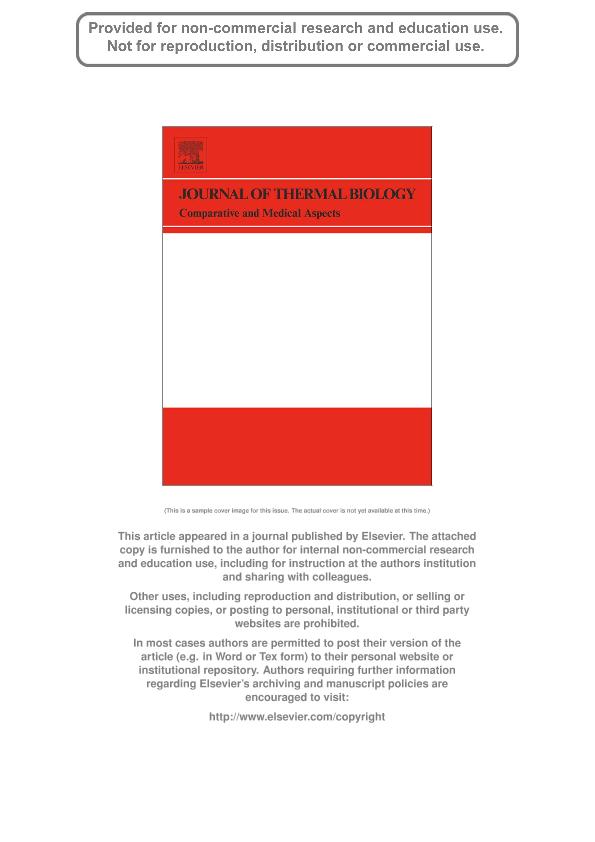Mostrar el registro sencillo del ítem
dc.contributor.author
Stellatelli, Oscar Aníbal

dc.contributor.author
Vega, Laura Estela

dc.contributor.author
Block, Carolina

dc.contributor.author
Cruz, Felix Benjamin

dc.date.available
2017-09-29T19:40:26Z
dc.date.issued
2013-01
dc.identifier.citation
Stellatelli, Oscar Aníbal; Vega, Laura Estela; Block, Carolina; Cruz, Felix Benjamin; Effects on the thermoregulatory efficiency of two native lizards as a consequence of the habitat modification by the introduction of the exotic tree Acacia longifolia; Pergamon-Elsevier Science Ltd.; Journal of Thermal Biology; 38; 3; 1-2013; 135-142
dc.identifier.issn
0306-4565
dc.identifier.uri
http://hdl.handle.net/11336/25493
dc.description.abstract
Habitat modification alters several aspects of the original fauna, among them the opportunity for thermoregulation. Here, we studied the thermal biology of sympatric populations of two lizard species (Liolaemus multimaculatus and Liolaemus wiegmannii) in two different situations; a grassland without trees (natural habitat) and in a grassland plus the exotic tree Acacia longifolia (modified habitat), aiming to assess whether the structural alteration of native Pampean coastal grasslands of Argentina affects the thermal biology of these lizards. Field body temperatures, laboratory preferred temperatures, microenvironmental temperatures, operative temperatures, thermoregulatory efficiency and spatial distribution of each species were analyzed in both habitats. Environmental operative temperature was 0.64 1C lower in the modified habitat (Te¼38.39 1C) than in the natural (Te¼39.03 1C). Thermoregulatory efficiency (E) of L. wiegmannii was lower in modified sites (E¼0.58) than in natural sites (E¼0.70). This difference may be because this lizard occupied shaded microhabitats under acacias, with suboptimal thermal features. In contrast, L. multimaculatus in the modified habitat restricted its activity to open microenvironments that retained a similar structure to that of the native habitat, while maintaining high thermoregulatory efficiency in both habitat types (Emodified¼0.92; Enatural¼0.96). Although these two lizard species are phylogenetically close, they respond differently to human-induced changes in their thermal environments. The introduction of A. longifolia into coastal grasslands for L. wiegmannii in particular, this introduction converts its native habitat into a suboptimal thermal environment
dc.format
application/pdf
dc.language.iso
eng
dc.publisher
Pergamon-Elsevier Science Ltd.

dc.rights
info:eu-repo/semantics/openAccess
dc.rights.uri
https://creativecommons.org/licenses/by-nc-sa/2.5/ar/
dc.subject
Thermoregulation
dc.subject
Exotic Plants
dc.subject
Habitat Modification
dc.subject
Lizard
dc.subject
Liolaemus
dc.subject.classification
Bioquímica y Biología Molecular

dc.subject.classification
Ciencias Biológicas

dc.subject.classification
CIENCIAS NATURALES Y EXACTAS

dc.title
Effects on the thermoregulatory efficiency of two native lizards as a consequence of the habitat modification by the introduction of the exotic tree Acacia longifolia
dc.type
info:eu-repo/semantics/article
dc.type
info:ar-repo/semantics/artículo
dc.type
info:eu-repo/semantics/publishedVersion
dc.date.updated
2017-09-21T18:01:46Z
dc.journal.volume
38
dc.journal.number
3
dc.journal.pagination
135-142
dc.journal.pais
Estados Unidos

dc.journal.ciudad
New York
dc.description.fil
Fil: Stellatelli, Oscar Aníbal. Consejo Nacional de Investigaciones Científicas y Técnicas. Centro Científico Tecnológico Conicet - Mar del Plata. Instituto de Investigaciones Marinas y Costeras. Universidad Nacional de Mar del Plata. Facultad de Ciencia Exactas y Naturales. Instituto de Investigaciones Marinas y Costeras; Argentina
dc.description.fil
Fil: Vega, Laura Estela. Consejo Nacional de Investigaciones Científicas y Técnicas. Centro Científico Tecnológico Conicet - Mar del Plata. Instituto de Investigaciones Marinas y Costeras. Universidad Nacional de Mar del Plata. Facultad de Ciencia Exactas y Naturales. Instituto de Investigaciones Marinas y Costeras; Argentina
dc.description.fil
Fil: Block, Carolina. Consejo Nacional de Investigaciones Científicas y Técnicas. Centro Científico Tecnológico Conicet - Mar del Plata. Instituto de Investigaciones Marinas y Costeras. Universidad Nacional de Mar del Plata. Facultad de Ciencia Exactas y Naturales. Instituto de Investigaciones Marinas y Costeras; Argentina
dc.description.fil
Fil: Cruz, Felix Benjamin. Consejo Nacional de Investigaciones Científicas y Técnicas. Centro Científico Tecnológico Conicet - Patagonia Norte. Instituto de Investigaciones en Biodiversidad y Medioambiente. Universidad Nacional del Comahue. Centro Regional Universidad Bariloche. Instituto de Investigaciones en Biodiversidad y Medioambiente; Argentina
dc.journal.title
Journal of Thermal Biology

dc.relation.alternativeid
info:eu-repo/semantics/altIdentifier/url/http://www.sciencedirect.com/science/article/pii/S0306456513000028
dc.relation.alternativeid
info:eu-repo/semantics/altIdentifier/doi/http://dx.doi.org/10.1016/j.jtherbio.2012.12.005
Archivos asociados
